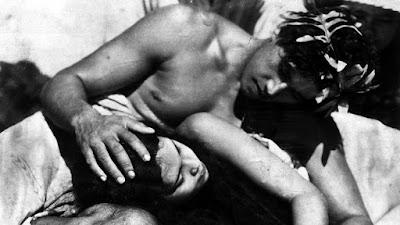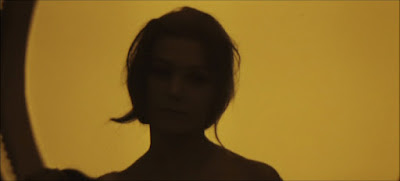Directed by Barry Jenkins, United States, 2016
Moonlight opens with a long shot following Juan in a regular day as a drug dealer in Miami's Liberty City neighborhood. The camera tracks behind him as he crosses the street, scoping out his surroundings. As he catches up with a younger dealer, the camera circles round and round the two of them, also taking in a strung-out addict begging for a free fix and a young man sprinting down the street while sirens blare in the distance. The roving, 360 degree camera movements reflect Juan's paranoid, cautious awareness of his surroundings. He can never let his guard down, not knowing what direction a threat might come from. He has a silent, stoic tough guy poise that we later realize is more of a defensive mask than his natural personality.
Moonlight has several such scenes, where the expressionistic camerawork reflects the emotions or mindset of its characters. We see a gentler side to Juan when he forms an unexpected friendship with Chiron, a young boy he finds alone in an empty drug den. Juan and his kind-hearted girlfriend Teresa become like surrogate parents to the quiet, sensitive but intense Chiron. In one gorgeous scene, Juan takes Chiron to the beach and teaches him how to swim. The camera mimics Chiron's perspective, bobbing in and out of the waves as Juan holds him in the water, then releases him to swim on his own. We feel, as Chiron does, the safety of Juan's arms, and the scary but exciting thrill of struggling independently through the choppy surf. Another shot from Chiron's point of view shows his mother, Paula, staring at him with hostility - and at us, directly into the camera. She's backlit by an ominous pink glow that heightens the intensity of her expression, which looks to Chiron like hatred. We see only brief moments between Chiron and Paula, who is addicted to drugs, but the glimpses of their relationship make it clear why he avoids home to seek shelter elsewhere.
Moonlight unfolds in three chapters, each covering several days at different points in Chiron's life. The first chapter, "Little", is about Chiron as a boy, "Chiron" as a teenager, and "Black" as a young man. The screenplay is an adaptation of the unpublished play In Moonlight Black Boys Look Blue by Tarell Alvin McCraney, which was based on his own life. McCraney grew up in Liberty City. His single mother was addicted to drugs, and passed away fairly young from HIV-related complications. Juan is based on a real man, Blue, a drug dealer who became like a father figure to young McCraney but died when he was only 7. Chiron's experiences with bullying and discomfort with himself as a gay kid and man are rooted in McCraney's own life. Moonlight's director, Barry Jenkins, also grew up in this neighborhood with a drug-addicted mother, though he and McCraney had never met until they collaborated on the project. Jenkins and McCraney know these streets and these people; Moonlight thrums with authenticity.
On paper, Moonlight might seem thin. The characters rarely explain their motivations or past histories, let alone speak their minds. We must fill in the gaps of their silences, and the missing time between the three chapters. Barry Jenkins's camera expresses what the characters cannot, making vivid their inner emotional lives that they prefer to keep hidden. An excellent ensemble cast also communicate so much, moreso through their body language than their dialogue. Mahershala Ali has limited screentime as Juan but makes a quietly powerful impression as a man living out a dangerous, toxic path. His relationship with Chiron is an expression of regret and a yearning for redemption and connection beyond his own dog-eat-dog world. Naomie Harris is frightening and heartbreaking as Paula, a woman who does have love for her son but has been overtaken by addiction and despair. She's the only actor to appear in all three chapters, transforming from a wrathful, larger-than-life figure in the eyes of young Chiron to a regretful, diminutive phantom of a person in the adult Chiron's perspective. Three actors play Kevin, a friend of Chiron and the man he falls for. Kevin is more comfortable in his own skin than Chiron, a friendly extrovert who more freely accepts his romantic desires in private though is just as unwilling to express them publicly. Jharrel Jerome and Andre Holland capture Kevin's confidence and charm, but also his underlying fear and insecurity.
Chiron is also played by three actors of different ages - Alex Hibbert, Ashton Sanders, and Trevante Rhodes, respectively. As a boy, he's all wide-eyed shyness and caution. As a teen, his coiled body language and clipped speech reveal his pent-up fury. The transformation between chapters two and three is the most shocking, as Chiron grows from a skinny boy to a hulking, muscular man. He speaks and moves more assertively, with a presentation that says, loud and clear, don't fuck with me. One of the dangers facing films where multiple actors play the same character is audience disbelief that they are actually watching the same person, but Moonlight draws a simple, persuasive character arc between the three iterations of Chiron. His peers and mother perceive his gentleness as weakness, and torment him for it, calling him "not a real man" or a faggot. As a teen Chiron is clearly overwhelmed with anger, and after a brutal incident he snaps, tired of being a victim. Chiron decides on a course of violent action, seeing it as the only way to protect himself. Barry Jenkins shows us Chiron's new decisiveness through his cinematography and Ashton Sanders's body language. He surveys his bloodied face in the mirror, an unfamiliar hardness in his eyes - one of many shots in Moonlight where a character directly, confrontationally stares into the camera. He then charges through the hallways of his school, intent on getting revenge on a bully. His movements are now laser-focused and aggressive, such a change from his previous timid and uncertain physicality. Even the colors in this scene reflect his newfound purpose, the bright blue of his shirt syncing with the blues of his school's hallways - he's becoming like his environment. Though his violent outburst is hardly unjustified it directly leads to the adult Chiron we later see - a drug dealer, unrecognizable beneath his muscles and impenetrable tough attitude.
A running theme in Moonlight is the impact certain expectations of masculinity have on men, gay or straight. In the world of Chiron, Kevin and Juan, to be a man is to be "hard". Vulnerability is punished, while violence is upheld as a man's way. Both Kevin and Chiron resort to violence as a tactic of survival and self-protection, though it's not behavior that comes naturally to either man. Juan is a small-time kingpin in his neighborhood, but in his interactions with Chiron we see a completely different man - one that is silently calling out for freedom from the cruel, false world he has mired himself in.
Moonlight illustrates a depressing cycle of violence and falsehood. As an adult, Chiron models himself after Juan - he becomes a drug dealer, drives a similar car with the same crown on the dash, owns a similar kind of pistol. We see him on the job and are reminded of Juan - the same paranoid awareness, the same shallow toughness, the same kind of half-threatening, half-businesslike interactions with a young underling. The world violently denied Chiron as himself, and he's responded by giving it what it expects from a man like him - poor, black, from a community overrun with drugs. For him, it's not only learned behavior but a way to survive. Moonlight makes clear that for all these characters, their actions are a form of survival. Paula uses drugs to escape her crushing loneliness. Kevin betrays Chiron to save himself. Juan deals drugs to blend in to his Darwinian society. Chiron resorts to drastic self-transformation to stay safe. The terrible irony is that they all end up contributing to the very systems and ideologies that have made their own lives hell, and by seeking survival have put themselves in terribly dangerous positions. We never learn exactly what happens to Juan, but it's not hard to guess, nor to see the same future for Chiron if he does not change.
In the final chapter of Moonlight, Chiron reconnects with two people from his past who have done him harm - his mother and Kevin. Kevin calls up Chiron and apologizes for his act of betrayal - Trevante Rhodes's performance is beautifully subtle in this moment, as Chiron's tough exterior falls away and we see the vulnerable little kid again. He drives to meet Kevin, recently released from prison and working in a diner. Though the first two acts of Moonlight are very moving, and punctuated with moments of brilliance, for me it's in the third act that Moonlight becomes truly great and powerful. As Chiron and Kevin reconnect in the diner, we are witness to an acting masterclass between Rhodes and Andre Holland. Every glance, gesture, and indirect statement is loaded with more meaning and emotion than is apparent on the surface. I found myself hanging on to every little nuance of their interaction, a sign of subtly brilliant acting, writing, and directing.
Moonlight's last act is astonishing for its quiet catharsis. Chiron begins to honestly reckon with himself, and to forgive. His story ends with luminous hope, a hope that Moonlight genuinely earns. It ends with redemption too - even for Juan, long gone from the story. Chiron breaks from the same path that took Juan, and instead heeds the better advice Juan shared with him as a kid - that he needed to decide for himself what kind of man he was going to be, not to let anybody else make that decision for him. Chiron finally speaks his heart, and as we've seen so much of his silence, his hurt, and his anger, his vulnerably honest words land with stunning power. We're not only seeing an individual man finally speak truthfully for himself, we're seeing the cyclical despair of his world finally broken.


















































